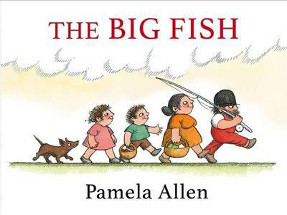The big fish by Pamela Allen

Penguin, 2016. ISBN 9780670078974
Once upon a time a little old man, a little old woman, a small boy
and a small girl went to spend the day by the river. The little old
man took out his fishing line, put some bait on his hook, and cast
it into the river because, like everyone who goes fishing, his dream
was to catch a really big fish.
I wish, I wish,
Oh, how I wish
I could catch a big fish!
It's not long before there is a tug on his line, so strong that he
nearly falls in and he has to call on the little old woman to help
him. But even together they are not strong enough so the little old
woman calls to the small boy. Will the old man and his family land
the catch - and just what is on the end of the line anyway?
This is a delightful story reminiscent of the traditional tale of
The enormous turnip and with its repetitive refrain and cumulative
language it has a rhythm that will draw the young listener in so
that soon they will be engaging with the language as well as the
story. And with a few simple necklace-type signs to designate their
roles, they will be clamouring to be involved in a re-enactment of
it immersing themselves even more so that it becomes a treasure
trove of riches for drama and a language study.
Students will love to tell their own tales of going fishing and the
tips and tricks they can pass on to their friends. They could make a
class map of favourite fishing spots - river, lake, sea, waterhole -
and investigate the sorts of fish that inhabit them that they might
catch. The class expert could explain the parts of a fishing rod and
the different types of lures that are used and why, as well as
explaining the procedure of getting a fishing line ready for use or
what to do with their catch once they have landed it. Speculating
and illustrating what is on the end of the old man's line offers
huge scope for the imagination and because the author doesn't
disclose what it is, no one can be wrong so the smug chorus of 'I
was right!' that usually accompanies predictive questions is
avoided.
There is a range of 'the mechanics of language' that could be
explored from understanding the word 'tug' and how the author shows
its meaning through its repetition to examining the various fonts
and how they add to both the meaning and the reading of the story.
Even the use of speech bubbles and exclamation marks and the
cumulative language structure can be discussed to help develop their
understanding of book language and the conventions used to make it
more like speech, thus enhancing their own reading through their
'inner voice'. Throughout, Allen uses words like 'tug', 'pull' and
'haul' so there could be an introduction to the concept of synonyms
and a challenge to find as many words that could be used to replace
'got' as possible.
The story also lends itself to the mathematics of size, order and
position particularly through the illustrations and the
re-enactment, offering lots of opportunities for the students to be
physically involved as they position themselves according to height
or age or gender.
Pamela Allen is one of the mainstay authors of literature for the
very young and she never fails to deliver the most wonderful stories
that are perfectly illustrated so that the marriage between text and
illustration is seamless. Even our very early readers can tell
themselves this story without having to have heard it let alone read
it for themselves. Miss Just-Turned-Five is going to love sharing
this with Grandad, an ardent but not always successful fisherman, as
they snuggle up for their bedtime story soon.
Barbara Braxton